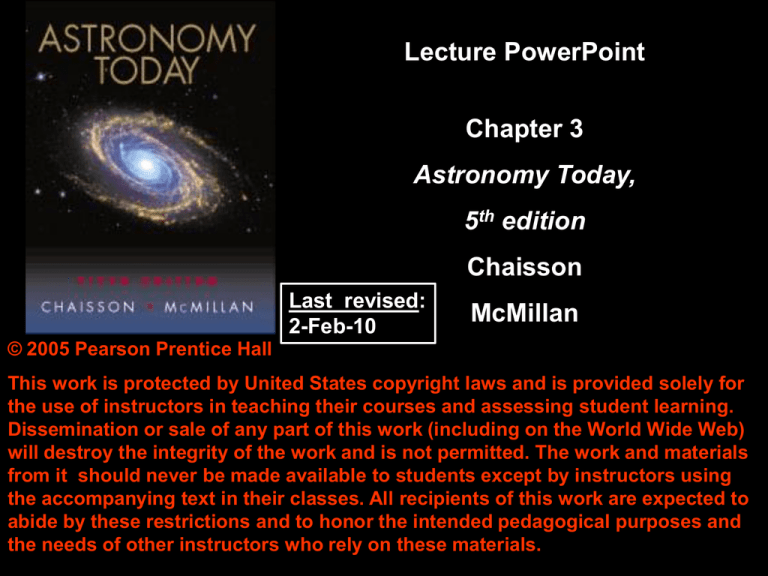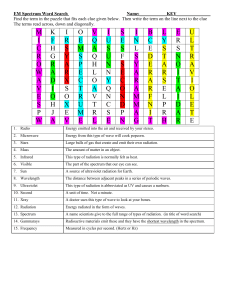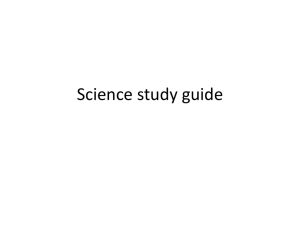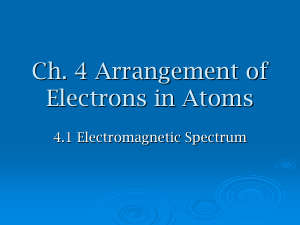
Lecture PowerPoint
Chapter 3
Astronomy Today,
5th edition
Chaisson
Last revised:
2-Feb-10
McMillan
© 2005 Pearson Prentice Hall
This work is protected by United States copyright laws and is provided solely for
the use of instructors in teaching their courses and assessing student learning.
Dissemination or sale of any part of this work (including on the World Wide Web)
will destroy the integrity of the work and is not permitted. The work and materials
from it should never be made available to students except by instructors using
the accompanying text in their classes. All recipients of this work are expected to
abide by these restrictions and to honor the intended pedagogical purposes and
the needs of other instructors who rely on these materials.
Chapter 3
Radiation
Units of Chapter 3
Information from the Skies:
- We can’t travel far away yet to sample stars directly
- We can study mainly light waves (photons) sent to us
- We can collect some particles (cosmic rays, neutrinos)
What is Light?
The Wave Nature of Radiation
The Electromagnetic Spectrum
- Discovery of the regions beyond the visible
- Atmospheric windows (visible, radio, a little UV & IR)
• Interactions of Radiation & Matter
Reflection, refraction, transmission, scattering,
absorption, emission
• Thermal Radiation
The Kelvin Temperature Scale
Radiation Laws
Planck equations
Wien’s Law
Stefan-Boltzmann Law
• The Doppler Effect
Determining speeds of various physical motions
by observed wavelength shifts
3.1 Information from the Skies
Electromagnetic Radiation: Transmission of
energy through space without physical
connection through varying electric and
magnetic fields
Example: Light
Andromeda Galaxy (M31)
2.2 million ly away
Interactions of Radiation & Matter
Reflection, refraction, scattering, transmission,
absorption, emission
3.1 Information from the Skies
Wave motion: transmits energy without the
physical transport of material
Wavelength: distance between peaks
3.1 Information from the Skies
Example: water wave (mechanical waves)
Water just moves
up and down
Wave travels and
can transmit
energy
3.1 Information from the Skies
Frequency: number of wave crests that pass a
given point per second
Period: time between passage of successive
crests
Relationships:
Frequency (n)= 1 / Period (T)
ln = c
3.1 Information from the Skies
Wavelength: distance between successive
crests
Velocity: speed at which crests move
Relationship:
Velocity = Wavelength / Period
v = wavelength x frequency
v = ln
3.1 Information from the Skies
Visible spectrum:
3.2 Waves in What?
Mechanical waves:
water waves, sound waves,
and so on, must travel in a
medium (water, air, …)
Electromagnetic waves:
need no medium to travel
Created by accelerating
charged particles:
3.2 Waves in What?
Electromagnetic waves: Oscillating electric and
magnetic fields. Changing electric field creates
magnetic field, and vice versa (J. C. Maxwell)
3.2 Waves in What?
What is the wave speed of electromagnetic
waves?
c = 3.0 × 108 m/s
This speed is very large, but still finite; it can
take light millions or even billions of years to
traverse astronomical distances
Sun: 8.3 light minutes
Nearest stars: (a-Centauri system): 25
trillion miles = 4.2 light years (ly)
Milky Way: 100,000 ly across
The wave nature of
radiation: radiation can
diffract and interfere,
which are purely wave
phenomena
__________
Young’s double
slit experiment:
Interference fringes
Particle model
Diffraction by a circular aperture
Discovery of the EM Spectrum
• William Herschel (1800) – Infrared &
Ultraviolet
• Heinrich Hertz (1887-8) – radio waves
• Wilhelm Roentgen (1895) – x-rays
• Ernest Rutherford (1900) – gamma (γ) rays
• Cleeton & Williams (1933) - microwaves
3.3 The Electromagnetic Spectrum
No limit on
wavelengths
Different ranges
have different
names:
Gamma
X-ray
Ultraviolet (UV)
Visible
n
Infrared (IR)
Microwave (MW)
Radio
λ
The Atmospheric Windows
satellites
rockets
balloons
airplanes
ground based
•For most of the time since the scientific revolution started
we could only use ground based instruments in the
visible region of the EM-spectrum (a little bit of IR & UV in
20th century)
•Airborne, balloon & rocket astronomy became important
after WW II (allowed x-ray, gamma, more IR & UV)
•Space astronomy began with Sputnik I in 1957 (all regions)
3.4 Thermal Radiation
°F
Kelvin Temperature
scale:
All thermal motion
ceases at 0 K
Water freezes at 273 K
and boils at 373 K
Absolute zero
°C
°K
3.4 Thermal (Blackbody) Radiation
Blackbody Spectrum: radiation emitted by an
object depending only on its temperature
Planck’s BB Radiation Eqt.
λmax
I(n)
(n )
3.4 Thermal Radiation
Radiation Laws
1. Wien’s Law:
Peak wavelength is
inversely proportional to
temperature
lmaxT = constant
= 2.9 x 10-3m
So,
T = 2.9 x 10-3 m
λmax
3.4 Thermal
Radiation
Radiation Laws
2. Total energy emitted
is proportional to fourth
power of temperature
(note intensity-the area
under the curves)
Stefan-Boltzmann Law:
E = sT4
Solar-Terrestrial Spectrum
Solar BB
radiation
5800 K BB
peak is here
Atmospheric
(telluric)
absorptions
Earth’s surface
BB radiation
3.5 The Doppler Effect
If one is moving toward a source of radiation, the
wavelengths seem shorter; if moving away, they
seem longer
3.5 The Doppler Effect
Relationship between frequency and speed:
(no)
(l)
(lo)
(n)
(v)
(c)
Dl = v
lo c
3.5 The Doppler Effect (anim. )
Depends only on the relative motion of source
and observer:
You’ve heard the Doppler effect
…and you’ve gotten a
speeding ticket from
it as well as seen the
weather reports
using it (animation)
3.5 The Doppler Effect Equation
Relationship between frequency and speed:
(no)
(l)
(lo)
(n)
(v)
(c)
Dl = v
lo c
Doppler Shift Calculation
rearrange to
If we detect a Hydrogen alpha spectral line from a
star or galaxy that is shifted 0.01 nm from its
wavelength in the lab (656.3 nm) then we can
determine how fast that object is moving towards or
away from us:
This is how the police determine your car speed.
They bounce microwaves off your car and measure
the wavelength shift & calculate your velocity.
Summary of Chapter 3
• Waves: period, wavelength, amplitude
• Electromagnetic waves created by
accelerating charges
• Visible spectrum is different wavelengths of
light (ROY G BIV)
• Entire electromagnetic spectrum:
radio waves, infrared, visible light, ultraviolet,
X rays, gamma rays (in order of increasing
frequency/energy)
•Atmospheric windows
Summary of Chapter 3, cont.
• Can tell the temperature of an object by
measuring its blackbody radiation (Wien’s
Law)
• Doppler effect can change perceived
frequency of radiation
• Doppler effect depends on relative speed of
source and observer
•Doppler effect can be used to determine
speeds of rotation, stellar and galactic
motions, detect extrasolar planets and more







